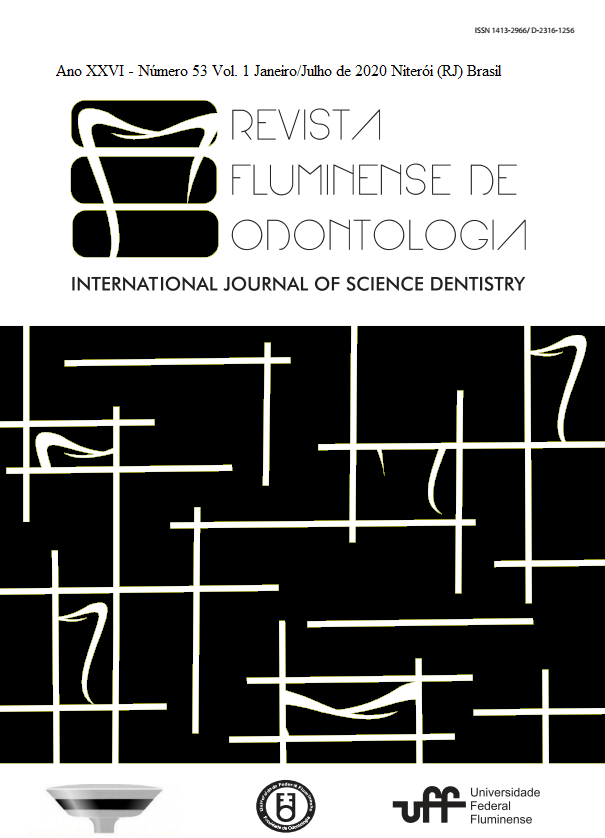TRATAMENTO CIRÚRGICO DE SIALOLITO DE GRANDES PROPORÇÕES EM GLÂNDULA SUBMANDIBULAR: RELATO DE CASO
DOI:
https://doi.org/10.22409/ijosd.v0i53.39862Abstract
Resumo
Sialolitos são estruturas calcificadas, que se desenvolvem no interior do sistema ductal salivar em decorrência da deposição de sais de cálcio ao redor de um acúmulo de restos orgânicos no lúmen do ducto glandular. Acometem mais frequentemente a glândula submandibular e são a causa mais comum de inflamações agudas ou crônicas nas glândulas salivares maiores. São mais frequentes em pacientes de 30 a 40 anos e duas vezes mais em homens do que em mulheres. Os sintomas geralmente se apresentam com o aumento da glândula salivar gerando tumefação local, febre, disfagia e dor. O diagnóstico correto envolve exame clínico, inspeção, palpação, manipulação da glândula e exames radiográficos. Podem ser evidenciados por radiografias convencionais, tomografia computadorizada, ressonância magnética, ultrassonografia, cintilografia, sialoendoscopia e sialografia. O tratamento inclui a eliminação espontânea mediante orientações ou uso de medicamentos sialogogos, ou a remoção cirúrgica do sialolito, sendo necessária, em alguns casos, a exérese da própria glândula. Este trabalho tem como objetivo relatar o caso clínico do paciente G.L.C, 70 anos de idade, sexo masculino, que compareceu ao Serviço de Cirurgia Oral e Maxilofacial do Hospital Federal dos Servidores do Estado, com queixa principal de dor e aumento de volume. Apresentava laudo de ultrassonografia evidenciando a presença de 3 cálculos medindo 10mm, 9mm e 8mm em glândula Submandibular direita. O paciente foi submetido à procedimento cirúrgico sob anestesia geral para exérese da glândula Submandibular que correu sem intercorrências. O paciente segue em acompanhamento pós operatório de 1 ano com boa evolução e sem sintomatologia.
Palavras-chave: sialolito; glândula submandibular; cirurgia oral e maxilofacial.
Abstract
Sialolites are calcified structures that develop within the salivary duct system due to the deposition of calcium salts around an accumulation of organic debris in the lumen of the glandular duct. They most often affect the Submandibular gland and are the most common cause of acute or chronic inflammation in the larger salivary glands. They are more common in patients aged 30 to 40 years and twice as often in men than in women. Symptoms usually present with enlargement of the salivary gland leading to local swelling, fever, dysphagia and pain. The correct diagnosis involves clinical examination, inspection, palpation, manipulation of the gland and radiographic examinations. They can be evidenced by conventional radiographs, computed tomography, magnetic resonance imaging, ultrasound, scintigraphy, sialendoscopy and sialography. Treatment includes spontaneous elimination through guidance or use of sialogogues, or surgical removal of the sialolith, and in some cases the removal of the gland itself is necessary. This paper aims to report the clinical case of patient G.L.C, 70 years old, male, who attended the Oral and Maxillofacial Surgery Service of the Federal Hospital of the State Servants, with the main complaint of pain and swelling. He presented ultrasound report showing the presence of 3 calculi measuring 10mm, 9mm and 8mm in the right Submandibular gland. The patient underwent a surgical procedure under general anesthesia for submandibular gland excision that ran uneventfully. The patient follows a 1-year postoperative follow-up with good evolution and no symptoms
Keywords: sialolite; submandibular gland; oral and maxillofacial surgery.


